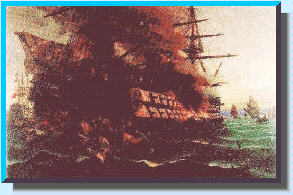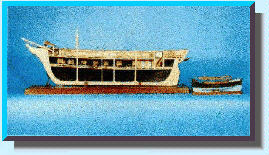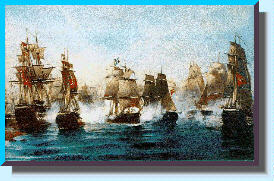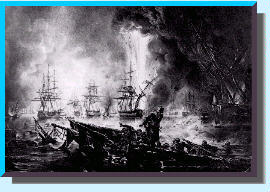The dark years of the Turkish occupation did not stop Greek naval activities. Greek seamen actively participated in war operations together with other christian states. For example, in the naval battle of Lepanto (Naupaktos 1571) they contributed to the crushing of the Turks, whilst in the naval battle of Tsesme (1770), Greeks from the island of Psara and other Greek fire-ships assisted the Russians with the destruction of the Turkish fleet. Further examples include Lambros Katsonis and Yiannis Stathas. Lambros Katsonis, with 18 Greek ships under his command and the favour of Catherine the Great, dominated the Aegean Sea from 1778 until 1792 and successively defeated the Turkish fleet. Yiannis Stathas hoisted a Greek Flag for the first time, and carried out raids from Cape Tainaron up to Propontis.
During this period, the extensive activity of Greek Mercantile marine, which was obliged to arm its ships, to fight against pirates, and to break though blockades to revictual the European belligerents, meant that the Greeks, particularly the islanders of Hydra, Spetsai, and Psara acquired an appreciable number of medium sized, well built and equipped ships. These ships, along with the tremendously experienced and war-ready crews with Greek naval tradition flowing in their blood, constituted a fundamental factor in the success of the war of independence that would follow. Thus, at the beginning of the Revolution of 1821, Greece had at her disposal approximately 1,000 small and medium sized merchant ships equipped with guns, and a force of 18,000 experienced and war ready seamen. Of these ships, approximately 150 were used at any one time as warships, and formed the fleets of the islands of Hydra, Spetsai and Psara, as well as war units of other islands.
At the beginning of the Revolution, the Navy claimed from the Turks the sovereign domination of the Aegean Sea and preserved it for almost the entire duration with an impressive series of victories.
Despite these victories, persecutions and devastation in Greece continued whilst the unpardonable discord and the personal conflicts of the Greeks rendered the work of Ibrahim even easier. And yet, in these difficult moments, the balance of favour began to shift towards the Greeks. The hard and merciless war, the successive heroism's and sacrifices (as for instance the holocaust of Messologgi) impressed Europe and gained the sympathy of the public opinion, which looked favourably on the Greek affair. Under pressure from their peoples, the Governments of England, France, and Russia jointly intervened in the conflict and demanded from the Turks a cease-fire and the recognition of a small Greek State. However, Ibrahim Pasha continuously infringed the agreements.
This infingment led an Anglo-Franco-Russian fleet under the command of the British admiral Sir E. Codrington, to enter Navarino Bay where the whole of the Turkish-Egyptian Armada was anchored. The purpose of this move was to persuade Ibrahim Pasha to honour the agreement and discontinue hostilities. However, a maladroit Turkish provocation against a British boat was the spark which immediately lit the terrible naval battle of Navarino on the 20th October 1827. In the afternoon of this historic day not a single ship remained out of the arrogant Turkish-Egyptian armada. The Allies lost no ship and only suffered minor losses. The rise of freedom had dawned and, in spite of the fact that the obstinacy of the Turks and of Ibrahim Pasha prolonged hostilities for considerable time, the Revolution had won. The Hellenic Nation after 400 years of slavery, gained with its merit and sword, as well as with its blood, its liberty and its independence.

On the night of the 6th June 1822, the Turkish fleet, after completing the destruction of Chios, was lying at anchor outside of the harbour with their vessels fully lit. Having slaughtered about 100,000 inhabitants (including women, children and the old) with a ferocity which shocked the civilised world, the Turks were celebrating the Bairam. The Greeks, whose ships were unable to arrive in time to prevent the catastrophe due to unfavourable winds, reached the decision to attack with two fire-ships under the command of Captains Pipinos and Canaris. With unimaginable daring the two reckless Captains slipped unnoticed among the fully lit Turkish ships. Pipinos attached his vessel to the Rear Admiral's flagship, but the Turks succeeded in having the fire-ship withdrawn in time. Canaris meanwhile, persisted in the task, and his helmsman J. Theophilopoulos, the famous Karavoyanos, succeeded in attaching the fire-ship's bowsprit into a gun-port hole on the Turkish flagship, the 1st rate three-decker MANSOURIYE. Canaris fastened his fire-ship securely and with the shout "The Cross wins", set the vessel on fire, jumped down into his waiting launch and drew off under heavy fire from the Turks. In a short time the Turkish flagship was in flames.
Panic ensued as the inferno took hold. It ended with an explosion that blew the ship into the air as soon as the fire reached the gunpowder store. Historians tell us that more than 2,000 persons, including guest officers from other ships, as well as other high ranking Turks, were on board celebrating, and fewer than two hundred were finally rescued. Among those killed was the ferocious Commander in Chief of the Turkish armada, Admiral Kara Ali who was struck on the head by a burning piece of one of his flagship's masts while climbing into a boat to escape. He was killed instantly. According to a statement by a French Officer,
"If the Greeks had more fire-boats that evening they would have succeeded in destroying the entire Turkish fleet".

Skabavia was the name given to the boat on which the fire-setting team escaped after they set the vessel on fire. Fire-ships were small, old ships, which were especially prepared and filled in a specific manner with flammable materials so that they could be set aflame immediately and transmit the fire to the enemy ship to which they were attached. The command and the effective use of a fire-ship required unsurpassed dexterity, seamanship and daring. The crew should be of particular courage, as while the fire-ship approached the enemy and the men with the grasps were ready to hook on to the enemy ship, they were exposed to a hail of bullets and shells. Fire-ships proved to be the main and most effective weapon of the revolutionary navy. Without them and the actual terror they spread among the Turks and Egyptians, it would had been very difficult for the small Greek ships to cause any serious damage to the huge and extremely strong Turkish two-deckers.

The sortie of the brig ARES from Navarino on 26th April 1825 is one of the most glorious exploits in the world's naval history. The brig ARES of the Hellenic Navy, was lying at anchor in the bay of Navarino in the early hours of the morning of the 26th April 1825, when the entire Turkish-Egyptian Armada appeared in front of the bay. A few small Greek vessels, which were lying in the bay sailed off to the open sea and it was only the ARES which delayed in departing, awaiting the return of her Captain, A. Tsamados. However, they were ignorant of the fact that he had already been killed defending the small island of Sfacteria at the entrance of the bay, during the Turkish assault. As soon as the ship's First Mate, N. Votsis, returned on board, he took over the command, with D. Sachtouris as his new First Mate, and the ARES set sail. However, by this time the outlet of the bay and the open sea were full of Turkish and Egyptian heavy ships.
Soon after, the icon of the Virgin Mary was brought up on deck by the sailors. The vessel, under full sail, took a course towards the outlet, but this was soon obstructed by two powerful Egyptian frigates which were intent on seizing her. By means of perfect steering and unbelievable dexterity, the ARES avoided the enemy's attempt, whilst at the same time causing them heavy damage with her 16 small guns. Emerging from the bay, the ARES found herself amidst the dense forest of masts belonging to the enemy fleet, which masked the horizon. The small cannons of the ship fired ceaselessly and with great accuracy, and inflicting severe damage to the enemy fleet. From Commander down to the youngest sailor, all carried out their duty with absolute perfection and with an amazing audacity, and the gallant ARES herself seemed to acquire her own soul and will.

The historical action in the Bay of Navarino consisted of the combined Turkish and Egyptian fleets, composed of 89 ships with a total of 2,240 guns (7 two-deckers of the line, 13 frigates, 30 corvettes, 28 brigs, 5 schooners and 6 fire-ships), and the combined fleets of the Allies composing of 27 vessels with a total of 1,312 guns (incliuding 3 ships of the line, 3 frigates, 2 corvettes, and 3 brigs). The General Officer in Command of the Allied Fleet was Sir Edward Codrington. The Allies plan when entering the the Bay of Navarino was not to come into combat, unless they were attacked. Instead they were to compel Imhrahim Pasha to comply with the Armistice Treaty of London which, under various pretexes, he was violating. A provocative action by the Turks, in shooting a British officer and some sailors in boat from the British frigate DARMOUTH, provided the fatal cause which started this formidable naval action. The aftermath in the bay was likened to a volcano.
The Hellenic Maritime Museum
Akti Themistokleous
Freattida
185 37 Piraeus
Hellas